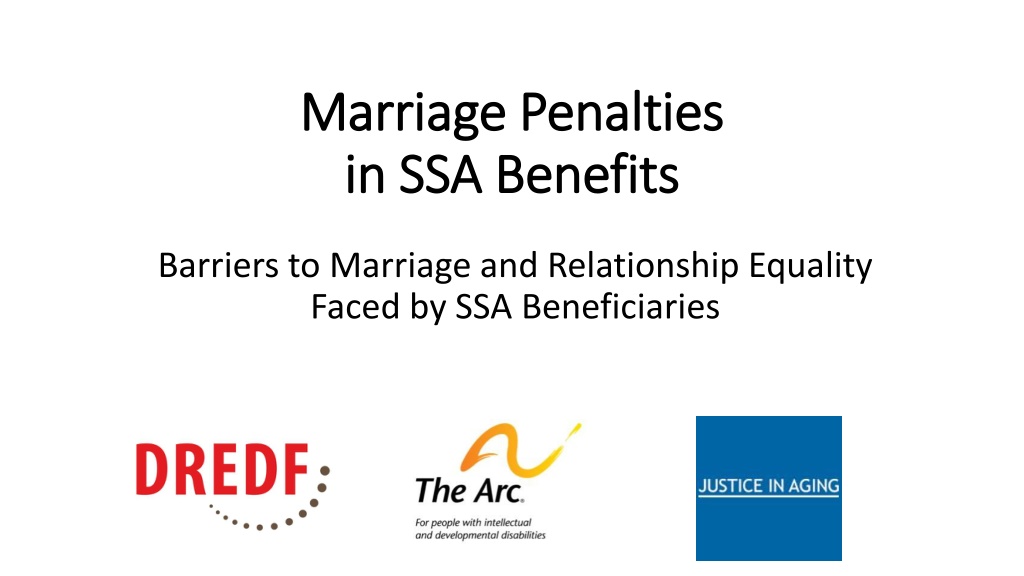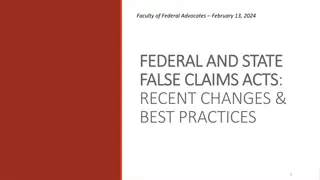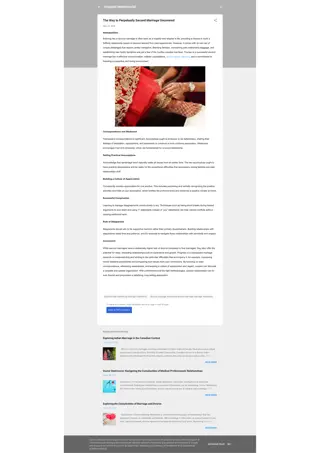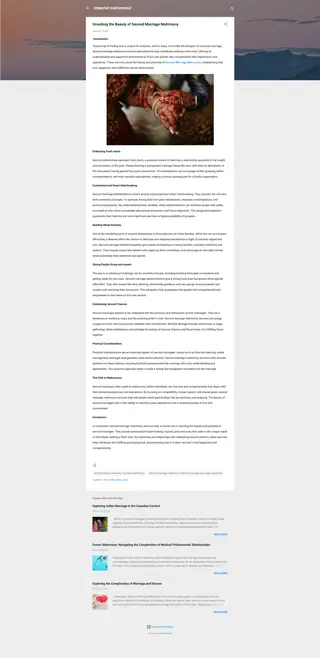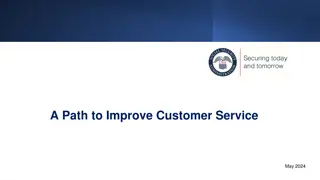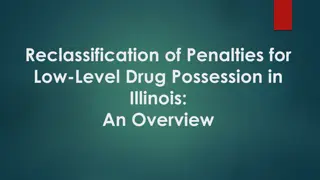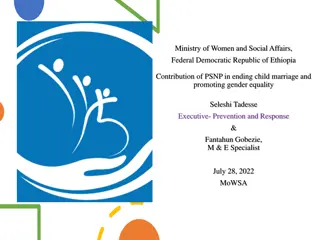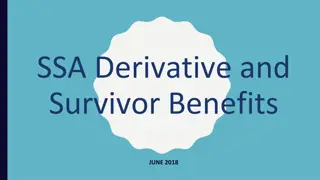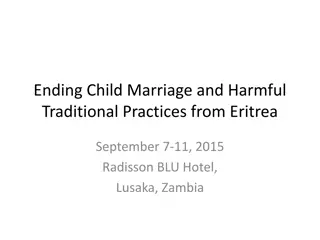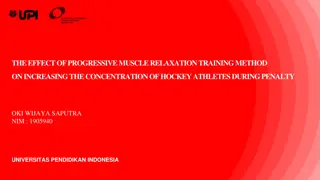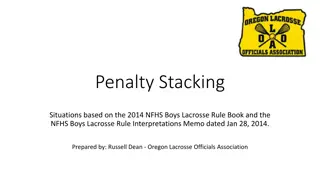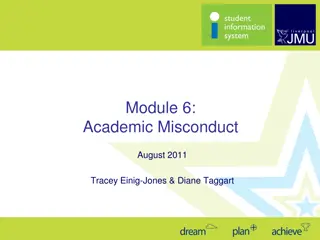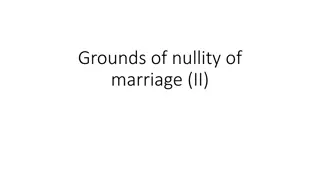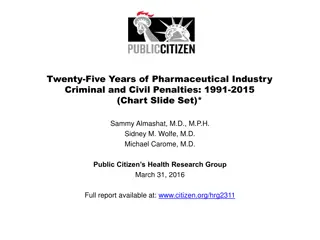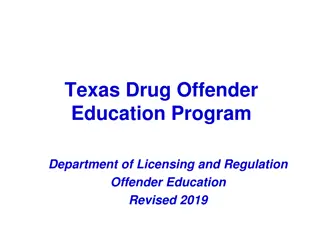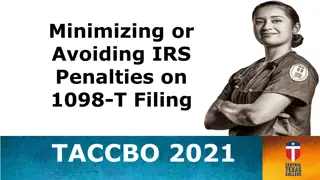Understanding Marriage Penalties in SSA Benefits
Explore the impact of marriage on Social Security Administration benefits such as SSI, including reductions in stipends and asset limits for married beneficiaries. Learn about barriers to marriage equality faced by SSA beneficiaries and how relationships affect benefit calculations.
Uploaded on Oct 01, 2024 | 1 Views
Download Presentation

Please find below an Image/Link to download the presentation.
The content on the website is provided AS IS for your information and personal use only. It may not be sold, licensed, or shared on other websites without obtaining consent from the author. Download presentation by click this link. If you encounter any issues during the download, it is possible that the publisher has removed the file from their server.
E N D
Presentation Transcript
Marriage Penalties Marriage Penalties in SSA Benefits in SSA Benefits Barriers to Marriage and Relationship Equality Faced by SSA Beneficiaries
CCD Working Group on Marriage Equality CCD Working Group on Marriage Equality American Civil Liberties Union The Arc Autistic Self-Advocacy Network Autistic Women and Nonbinary Network Cure SMA Disability Rights Education & Defense Fund Justice in Aging National Committee to Preserve Social Security and Medicare National Disability Rights Network National Down Syndrome Congress National Down Syndrome Society National PLAN Alliance Paralyzed Veterans of America Spina Bifida Association United Spinal And more
Marriage & Relationship Penalties Marriage & Relationship Penalties Overview Overview Two SSI beneficiaries in relationship Married : 25% cut in stipend and asset limit Unmarried but found holding out : 25% cut in stipend and asset limit Two people, one DAC beneficiary and one not (and not receiving another Title II benefit), in relationship DAC benefits end with marriage Two people, one SSI beneficiary and one not, in relationship Married spousal deeming of income and assets from non-SSI spouse to SSI spouse (affecting benefits) Unmarried but found holding out : spousal deeming (affecting benefits) Unmarried and no holding out, resources from non-SSI spouse can be in-kind support and maintenance (affecting benefits)
Two Married SSI Beneficiaries Two Married SSI Beneficiaries 25% Cut 25% Cut Under federal statute, two married SSI beneficiaries get a joint stipend and joint asset limit that is 25% lower than for two unmarried SSI beneficiaries Stipend: Two unmarried SSI beneficiaries: $841 + $841 or $1682 total Two married SSI beneficiaries: $1,261 total Asset Limit: Two unmarried SSI beneficiaries: $2000 + $2000 or $4000 total Two married SSI beneficiaries: $3000 total Citations: 42 U.S.C. 1382(a) & (b); https://www.ssa.gov/ssi/text-benefits-ussi.htm; https://www.ssa.gov/ssi/text-resources-ussi.htm
Two Unmarried SSI Beneficiaries Two Unmarried SSI Beneficiaries Holding Out As Married Holding Out As Married Same 25% Cut Same 25% Cut SSA can decide that two SSI beneficiaries are holding out as married, even if the couple is not legally married A finding of holding out means the couple is subject to the same 25% cut in stipend level and asset limit Citations: 42 U.S.C. 1382c(d)(2); 20 C.F.R. 416.1806(a)(3), 416.1826(c), 416.1832(d)
Holding Out Inquiry Under POMS Holding Out Inquiry Under POMS Questions re holding out for two SSI beneficiaries living together: What name or names are you known by? How do you introduce the other person to friends, relatives, or others? How is mail addressed to you and to the other person? Are there any bills, installment contracts, tax returns, or other papers showing you as spouses? Is the place where you live owned or rented by both of you or only one? Not holding out if obvious reason to live together other than as a couple : living together due to employer-employee relationship living together only for the purpose of sharing expenses Citations: POMS SI 00501.152; GN 00210.800; Form SSA-4178
Disabled Adult Child (DAC) Marriage Penalty Disabled Adult Child (DAC) Marriage Penalty DAC beneficiaries: disabled before age 22 child of insured parent who is deceased or currently receiving SSDI or Social Security retirement DAC beneficiaries receive stipend, Medicare, pathway to Medicaid DAC beneficiaries who marry lose DAC Exceptions to rule: spouse is another DAC, a person receiving SSDI, a person entitled to old age SSA benefits (earliest age 62), or a person receiving another secondary Title II benefit; Note: SSI spouse is not within exception Citations: 42 U.S.C. 423(d)(1), (5), 1382(a), (b); https://www.hhs.gov/guidance/document/2002groups-deemed-be-receiving-ssi-medicaid- purposes
SSI Beneficiary Married to Non SSI Beneficiary Married to Non- -SSI Spouse Spousal Deeming of Income and Assets Spousal Deeming of Income and Assets SSI Spouse SSI beneficiary married (or found holding out ) to non-SSI spouse: Portion of income of non-SSI spouse is allocated to SSI spouse Countable assets of non-SSI spouse are allocated to couple Benefits and eligibility affected Countable assets of non-SSI spouse are allocated to the couple; if value exceeds $3,000, then SSI beneficiary no longer eligible Example: bank account of non-SSI spouse holds $3,100 Citations: 42 U.S.C. 1382c(f); 20 C.F.R. 416.1163, 416.1165; POMS SI 01310.160, SI 00501.150
SSI Beneficiary Married to Non SSI Beneficiary Married to Non- -SSI Spouse Spousal Deeming (cont.) Spousal Deeming (cont.) SSI Spouse Small income by non-SSI spouse less than $1,000 a month (below the federal poverty level) can cause SSI stipend to decrease Modest income by non-SSI spouse about $32,300 a year (less than half the US median) brings federal portion of the SSI stipend to zero, which can make SSI beneficiary ineligible for Medicaid Citations: 42 U.S.C. 1382c(f); 20 C.F.R. 416.1163, 416.1165; POMS SI 01310.160, SI 00501.150
In In- -Kind Support and Maintenance Kind Support and Maintenance If unmarried SSI beneficiary lives with non-SSI partner, contributions by non-SSI partner to household living can decrease benefits under In-Kind Support and Maintenance (ISM) rules. For example: Household expenses paid by non-SSI partner can reduce stipend by up to one-third of FBR + $20 ($300.33 for 2022) under Presumed Maximum Value (PMV) rule If SSI beneficiary lives with their partner and is not on the lease, SSA could find that SSI beneficiary does not pay their fair share of housing expenses and reduce stipend by one third under the Value of the One-Third Reduction (VTR) rule Citations: 42 U.S.C. 1382a(a)(2); 20 C.F.R. 416.1130 416.1148; POMS SI 00835.000 et seq.; see also SI 00835.300; SI 00835.200
Poverty Rates of SSI and DAC Beneficiaries Poverty Rates of SSI and DAC Beneficiaries More than 40% of SSI beneficiaries live below the federal poverty level Nearly 36% of DAC beneficiaries live below the federal poverty level SSI and DAC beneficiaries have highest poverty rates of all beneficiary groups Citations: https://www.ssa.gov/policy/docs/rsnotes/rsn2015-02.html; https://papers.ssrn.com/sol3/papers.cfm?abstract_id=3507766
Medicaid = Access to Disability Supports Medicaid = Access to Disability Supports SSI provides Medicaid and DAC provides a pathway to Medicaid Medicaid is the exclusive vehicle in our society for services and supports needed for people with significant disabilities, such as: Primary and preventive health care Medical services for illnesses and chronic conditions Durable medical equipment including wheelchairs and lifts Personal attendant care services and other , and other home- and community-based services Supportive housing services and employment services Medicaid is what enables many disabled individuals to be integrated members of their communities
Additional Harms Imposed by Marriage Additional Harms Imposed by Marriage Penalties On Disabled Constituents Penalties On Disabled Constituents Limitations on forming families Lack of social recognition of important relationships Inability to engage in religious practices/conflict with religious beliefs Disconnection from community
Eliminating or Reducing Marriage Penalties Eliminating or Reducing Marriage Penalties Bills Introduced in Congress Bills Introduced in Congress SSI Restoration Act, https://www.congress.gov/bill/117th-congress/senate- bill/2065 Would eliminate 25% penalty Marriage Equality for Disabled Adults Act, https://www.congress.gov/bill/117th-congress/house-bill/6405 Would eliminate DAC penalty Additional bills: MAPSA, https://www.congress.gov/bill/117th-congress/house-bill/761/text SSI Savings Penalty Elimination Act, https://www.law.cornell.edu/uscode/text/42/1396r-5
Reducing Marriage Penalties Reducing Marriage Penalties Agency Actions Agency Actions Mitigate 25% cut Clarify holding out standard apply only to affirmative representations by both individuals of marriage under state law; disclaim functional analysis & articulate safe harbor Mitigate Spousal Deeming Allow spousal living allowance (deduction from non-SSI spouse s income) Revise and clarify holding out standard as stated Administrative process for RFRA claims Better public education and guidance on complex rules Esp. DAC penalty and holding out rules Comprehensive report on penalties and reforms Citations: https://www.ssa.gov/policy/docs/issuepapers/ip2003-01.html; Beaty v. Berryhill, No. 2:18-cv-00519 AC, 2019 U.S. Dist. LEXIS 81373 (E.D. Cal. May 13, 2019)
Questions and Answers Questions and Answers
